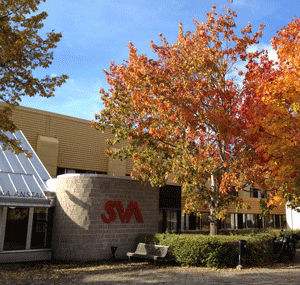Department of Disease control and Biosecurity
The Swedish National Veterinary Institute (SVA) is a Swedish Government authority under the Ministry of Agriculture and is the largest and only official laboratory in veterinary medicine in Sweden. Total number of employees is 400, and activities at the institute are focused on diagnostic work and advisory services, official services/governmental duties and commissioned research. The Department of Disease control and Biosecurity at SVA provides expert advice on contagious diseases in animals, including zoonoses, including investigations and programmes for their control. The Department is responsible for the design, implementation and evaluation of active surveillance on statutory diseases as well as other infectious agents of national concern.
 Role in the project
Role in the project
Participant in WP 1, 2, 3, 4 and 5 | Conceptual surveillance framework development | Development of frameworks and tools for disease detection, freedom from disease and case detection | Facilitate communication with Swedish policy makers and other stakeholders | Provision of Swedish data for case studies | Carry out case-studies on real data from the Swedish surveillance programme in WP 3 and 4 | Development of e-learning material and moderation of the discussions in the online support service for CAP and CAHP in WP 7.
Key-persons assigned to RISKSUR
Assoc. prof. Ann Lindberg
Graduated from The Swedish University of Agricultural Sciences (SLU) | Currently Head of Section of the Swedish Zoonosis Centre | Before joining the National Veterinary Institute, Epidemiologist with the Swedish Dairy Association | key expertise is the design, implementation and evaluation of large scale surveillance and control
Dr. Arianna Comin
Graduated in Veterinary Medicine from the University of Padova (Italy) │PhD in Animal breeding and quantitative genetics (Padova, Italy) │PhD in Veterinary Epidemiology (Utrecht, The Netherlands). Formerly working as veterinary epidemiologist and data analyst at Istituto Zooprofilattico Sperimentale delle Venezie (Italy). │Her key expertise is design and evaluation of surveillance systems for animal diseases
Dr. Fernanda Dórea
veterinarian graduated in Brazil | Masters in infectious disease modeling (UGA, USA) | PhD in epidemiology focusing on the use of data mining for automated generation of epidemiological information (UPEI, Canada) | Implemented and continuous do develop SVA’s syndromic surveillance system
Assoc. prof. Jenny Frössling
Graduated from SLU │ Holds current position as an Epidemiologist within the Section of Epizootology │ Performs research (part time) for the Swedish University of Agricultural Sciences │ Her key expertise is sampling design, risk-based evaluation of surveillance activities and test interpretation
Dr. Thomas Rosendal
Graduated from University of Guelph (Ontario, Canada) | PhD in epidemiology focused on PRRSV spatial and temporal spread modeling | Worked for the University of Alberta, Canada on modeling disease freedom from CWD in domestic cervids.
Assoc. prof. Helene Wahlström
Graduated from The Royal Veterinary College in Stockholm│Before working as an Epidemiologist for the Swedish Zoonosis Centre, she was employed as a Laboratory Veterinary Officer within the Dept. of Epizootology at the National Veterinary Institute │ key expertise is the design of surveillance and control of diseases
Other relevant projects
EPIZONE: Network of Excellence for Epizootic Disease Diagnosis and Control.
ASFRISK: Evaluating and Controling the Risk of African Swine Fever in the EU.
AniBioThreat: Bio-preparedness measures concerning prevention, detection and response to animal bio-threats.
Relevant Publications:
Frössling J, Wahlström H, Ågren ECC, Cameron A, Lindberg A & Lewerin SS 2013. Surveillance system sensitivities and probability of freedom from Mycobacterium avium subsp. paratuberculosis infection in Swedish cattle Preventive Veterinary Medicine, vol. 108, pp. 47-62.
Espetvedt M, Lind AK, Wolff C, Rintakoski S, Virtala AM, Lindberg A. (2013) Nordic dairy farmers' threshold for contacting a veterinarian and consequences for disease recording: Mild clinical mastitis as an example. Preventive Veterinary Medicine, vol. 108:114-24.
Dórea FC, McEwen BJ, McNab WB, Revie CW, Sanchez J. 2013. Syndromic surveillance using veterinary laboratory data: data pre-processing and algorithm performance evaluation. J R Soc Interface doi: 10.1098/rsif.2013.0114.
Frössling J, Ohlson A, Björkman C, Håkansson N & Nöremark M 2012. ‘Application of network analysis parameters in risk-based surveillance – Examples based on cattle trade data and bovine infections in Sweden’ Preventive Veterinary Medicine, vol. 105, pp. 202-208.
Comin A, Stegeman A, Marangon S, Klinkenberg D 2012. Evaluating surveillance strategies for the early detection of low pathogenicity avian influenza infections. PLoS ONE 7(4) e35956. doi: 10.1371/journal.pone.0035956
Comin A, Stegeman A., Klinkenberg D., Busani L., Marangon S 2011. Design and results of an intensive monitoring programme for avian influenza in meat type turkey flocks during four epidemics in northern Italy. Zoonoses Public Health. 58: 244–251
Dórea FC, Sanchez J, Revie CW. 2011. Veterinary syndromic surveillance: Current initiatives and potential for development. Preventive Veterinary Medicine vol. 101, 1-17.
Nöremark M, Håkansson N, Lewerin SS, Lindberg A & Jonsson A, 2011. ‘Network analysis of cattle and pig movements in Sweden: measures relevant for disease control and risk based surveillance’, Preventive Veterinary Medicine, vol. 99, no. 2-4 , pp. 78-90.
Wahlström H, Frössling J, Lewerin SS, Ljung A, Cedersmyg M & Cameron A, 2010. ‘Demonstrating freedom from Mycobacterium bovis infection in Swedish farmed deer using non-survey data sources’, Preventive Veterinary Medicine vol. 94, no. 1-2, pp. 108-118.
Frössling J, Ågren EC, Eliasson-Selling L & Lewerin SS 2009. ‘Probability of freedom from disease after the first detection and eradication of PRRS in Sweden: scenario-tree modelling of the surveillance system’ Preventive Veterinary Medicine, vol. 91, no. 2-4, pp. 137-45.
